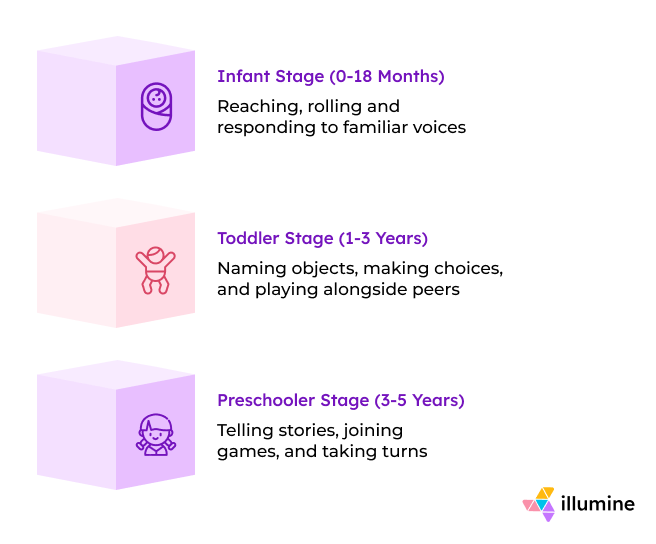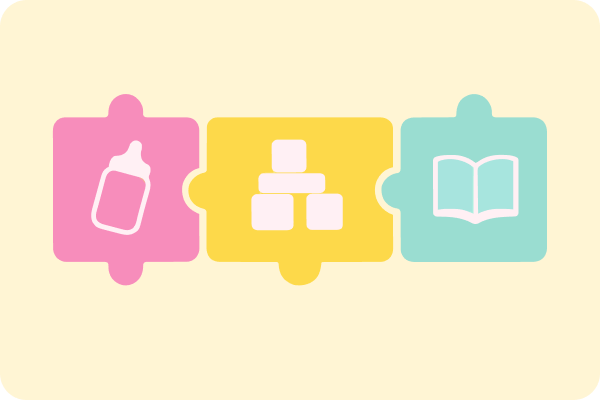If you’re a parent, you already know childhood doesn’t move in straight lines. One week your baby hates tummy time. The next week she is inching across the rug to steal the dog’s toy. That’s why understanding the infant age group, the toddler age group, and the preschool age range helps. The journey from birth to preschool is marked by certain milestones that signal your child’s growth and development. It gives you a simple map when the days feel messy.
👉 Note: Ages and staff ratios can vary by country, state, and provider. Use these as typical ranges and confirm details with your center.
A Quick Way to Picture the Early Years

Think of a normal Tuesday at home.
- Infant (0–18 months): You lay your baby on the mat with a soft rattle. She studies your face, babbles “ba-ba,” and kicks with all her might. You move the toy two inches away and she reaches with a proud grunt. That is early learning in action.
- Toddler (1–3 years): Your 2-year-old insists on the blue cup, not the green one. He labels everything on your walk: “bus, dog, big tree.” He plays next to another child at the park. They don’t talk much, but they copy each other’s moves. Playing with others at this age supports social development as they begin to imitate and interact with age-matched friends.
- Preschooler (3–5 years): Your 4-year-old tells you long stories about a dragon named Peanut and then leads a game of Simon Says. She is still learning to wait, but she understands turn-taking if you keep it short. Playing with children her age helps her learn cooperation and important social rules.
These everyday moments are how children of different age groups learn.
Why Age Groups Matter in Real Life
On paper, age bands look like numbers. In real life, they shape the day—how teachers plan, how kids feel, and what parents can expect.
- Safety & supervision: A room of crawlers needs floor space and close spotting; a room of runners needs clear paths and outdoor time. Ratios change for a reason.
- Right-sized activities: Finger paint for toddlers; simple scissors and pattern games for preschoolers. The right fit keeps kids engaged and calm.
- Social-emotional timing: Two-year-olds practice parallel play; four-year-olds try team rules. Mixing stages without support can spark avoidable conflict.
- Language growth: Toddlers label (“bus! dog!”); preschoolers tell stories. Teachers plan talk time differently for each group.
- Transitions that stick: Moving from the toddler age group to preschool is smoother when routines, nap plans, and toileting expectations match the child’s stage.
- Clear expectations for parents: You’ll know what “a good day” looks like at each stage—and when to ask for more support or the next room.
A quick picture:
If your two-and-a-half-year-old melts down at circle time, it’s not “bad behavior.” It’s a mismatch. Shorter group times belong to the toddler room; longer ones to preschool. Age groups help the day fit the child.
Age Groups at a Glance: What to Expect and What to Try
Here’s a quick table of the infant, toddler, preschool, and school-age groups. Scan it for typical ratios, everyday signs to look for, and simple activities to try at home or ask about on a tour. Child-to-adult ratios can vary by state, so confirm locally. Watch readiness signs to know when it’s time to move up.
Infant Age Group: What Age Range Is an Infant?
Typical range: 0–18 months
Developments you will notice
- Rolling to sitting to crawling, then maybe wobbly steps
- Babbling, first words like “mama,” “dada”
- Locking eyes, smiling, and calming with a familiar voice
Try this at home
- Put a soft toy just out of reach during tummy time to build strength
- Narrate your day: “Red spoon. Warm bath. Quiet song.”
- Keep a simple wind-down routine. Lights down. One lullaby. Same order each night.
When you tour daycare
- Look for clean floor spaces where babies can move freely
- Ask how teachers respond to cries and how they share updates
- Typical ratio: 1 adult for 3–4 infants. Verify locally.
Toddler Age Group: What Age Is a Toddler?
Typical range: 1–3 years is within broader toddler age ranges
What you’ll notice
- Language bursts: single words to short phrases
- Simple puzzles, sorting by color or shape, pretend play with pots and pans
- Parallel play next to other children, with early turn-taking if guided
- Running, climbing, throwing, stacking blocks
- Developing a strong sense of self and independence
Try this at home
- Offer real choices you can honor: “blue cup or green cup”
- Take a short “label walk” and name what you see: “bus, cloud, tall tree”
- Keep naps predictable. A short book and quiet music help the switch-off
When you tour daycare
- Look for short, hands-on activities and lots of outside time
- Ask how teachers handle sharing, biting, and big feelings
- Typical ratio: 1 adult for 3–6 toddlers. Verify locally.
Older toddlers (2–3): the bridge to the preschool age range
This is when you see small “I can do it” moments. Your child carries snack napkins to the table, washes hands with a tiny stool, and joins a very short group game. Ask the center how they support toilet readiness and how they help children who are dropping naps. Also, inquire about how the center supports the preschool transition for older toddlers, including managing separation anxiety and helping children adjust to a new environment.
Preschool Age Range: What Ages Are Considered for Preschool?
Typical range: 3–5 years is within the preschool age group
Most children start preschool around ages 3 to 4. The “right” time isn’t a number though. It depends on your child’s readiness and what works for your family. A good preschool program builds language, social skills, and confidence, and it helps children step into kindergarten at about age 5 feeling prepared. One practical note: many programs use birthdate cutoffs, so your child’s birthday can affect when they’re eligible to start.
What you’ll notice
- Longer sentences, more questions, first jokes
- Counting, patterns, name writing, early story sequencing
- Cooperative play with rules everyone agrees on
- Pedaling, hopping, cutting along a line with child-safe scissors
Try this at home
- Read daily and ask open questions: “What do you think happens next?”
- Play simple board games. Practice waiting one turn without making it a battle
- Give small jobs: put spoons on the table, match socks, wipe a spill
When you tour preschool
- Look for play-based centers: blocks, art, pretend play, books, outdoor space
- Ask how they communicate with families and how they help with friendship hiccups
- Some programs consider a child's birthday when determining eligibility to start preschool.
- Typical ratio: 1 adult for 6–10 preschoolers. Verify locally.
When Do Kids Start Daycare? Minimums, Earliest Starts, and Limits
Daycare is a valuable resource for working parents, providing a safe and nurturing environment for children while parents manage their work responsibilities. Parents often ask what age do kids go to daycare, the youngest age for daycare, and whether there is a daycare age limit.
- Youngest or minimum age: Many centers start infants at 6–12 weeks. Some prefer 3–6 months. Home-based programs may differ.
- Common entry points: 18–24 months for toddlers, or 3 years for the preschool age range.
- Daycare age limit: Many programs serve children until kindergarten entry. Some offer aftercare for school-age kids.
- A gentle start: If you can, begin with shorter days. Ask about gradual transitions, especially for infants and young toddlers
Preparing Your Child: Tips for a Smooth Transition to Preschool or Daycare
For toddlers around 18 months to 3 years, this might be the first real stretch away from you. They’re learning to play near other kids, follow simple directions, and try things on their own.
Talk about what will happen in simple words. “You’ll meet Ms. Riya. There’s a slide. I’ll pick you up after snack time.” Visit the classroom if you can. Point out where coats go, where the blocks are, where the bathroom is.
Set a steady rhythm at home. Predictable meals, naps, and play help kids feel safe. Practice small independence every day: shoes on, hands washed, choosing between two snacks.
Plan a goodbye ritual for day one. A hug, a high-five, a short “See you after snack time.” Keep it brief and confident. It’s okay if there are tears. Teachers know how to help, and most kids settle once the day gets going.
Cheer the little wins. “You hung your backpack.” “You said bye and walked in.” Those moments build confidence. With your calm and a few dry runs, your child will be ready to learn, play, and make new friends.

A Few Real Questions to Ask While Touring a Center
- How do you help a child who cries at drop-off?
- What does a calm-down space look like in your toddler room?
- How do you talk about fairness and turn-taking with preschoolers?
- How do families get updates during the day? Photos, notes, or a daily report?
- What is your policy on naps for older toddlers who are starting to drop them?
How illumine helps parents and centers
Final thoughts
You do not need a perfect plan. You need a simple one. Know where your child is today—infant, toddler, or preschool age range—and give them the next right step. A toy just out of reach. A choice between two cups. A story before bed. The big leaps start with small, ordinary moments done again and again.











.webp)